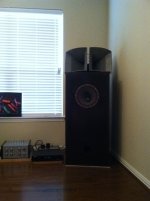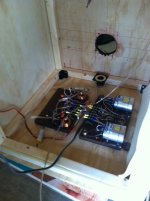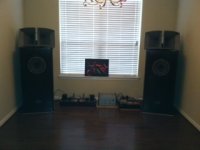Greets!
1] Yes, due to the tall cab’s ¼ WL pipe action damping the vent, it will take [3] 4” dia. x 0.75” [baffle thickness] vents for ~15 ft^3/27 Hz, so no need for tubes.
2] For high aspect ratio cabs it’s a good plan to locate the ventdown ~80-86% of its inside [i.d.] length
OK, final design:
H = 60”
W X D [CSA] = 432”^2 [suggest a golden ratio 26.43” x 16.375”]
Vent = [3] 4” dia. [or 1.875” x 20.125” slot] x 0.75” baffle thickness
driver up 37.25”
Vent up 6.75”
Damp to ‘taste’. FWIW, I prefer 1” acoustic fiberglass insulation on the top, one side and back down to 40” and add more down further and even its floor if need be to quell if there’s any in-room bass ‘boom’.
There’s a number of suggested bracing schemes in these designs: Frugal-phile DIY Audio Community Site
Messed with the original Cobreflex some back in the ‘60s and at this point in time all I remember is that the Altec 511 was clearly superior for a 500 Hz XO point HIFI apps, so you may need to up it to 800 Hz.
You’re welcome! Hope you come back and post pictures along with a mini revue.
GM
Hello GM;
It took me almost 3 weeks to finish these enclosures since I am a full time employee.
And I would like to say "sorry" that i did not follow your suggestions: not because i dont like it but because i could not handle that tall (60")- cutting, transportation, assembling etc..
I am a beginner and this is the first my speaker project, i have very limited tools...
anyway specs detailed below-
H :48"
W X D 540"^2(24" X 22.5")
vent = 4" dia X 0.75" (length)
driver up: 31"
vent up: 6"
damping : 1/2" acoustic foam- top, one side and back( as you recommended, damping - i will change to fiberglass sometime nextweek)
XO cut: 800Hz and 3500Hz
I am still doing tuning on damping and port length but when i hooked up to amp, very clear sound came out of these speakers, violin, cello and especially vocal sound continuously develops but not enough bass. I do not have any equipment to test these speakers so i have to depend on my ears.
Qs:
1. I feel like bass is not enough......any suggestions?
- change vent length or add more damping
2. how does sound different if i add more damping.
3. Is there any ways that I can improve bass?
Thank you for your help!
Attachments
Last edited:
Greets!
No problem, didn’t recall your needing to build it elsewhere and/or a 48” height limit or I would have optimized for it.
Anyway, for my records, are these internal or external dimensions?
Either way, the vent is way too small, so is tuned way too low, in theory having a very rolled off bass with a ‘one note’ peaking at Fb around ~22 Hz.
I spec’d [3] 4” vents with a ~ 40 Hz Fb for a 48” height, which should dramatically increase both the bass and mid-bass, especially with corner loading, maybe even too much.
If it’s still not enough though, then the mid horn, HF horns will need to be shelved down as required to tonally balance them. This is a very simple/crude version of baffle step compensation [BSC] though, so long term you may want to either make a passive version to dial it in or use digital EQ since the actual BSC midpoint is usually in the 250-500 Hz BW.
The more damping, the more the bass rolls off and at some point it can become ‘muffled’ sounding/’dull’ [‘suck the life out’ of the lower mids].
No experience with most foams, just know that the few I tried many decades ago were best suited for small sealed cabs, so probably not relevant to current ‘acoustic’ foams.
Regardless, no matter what material is used, it requires critically listening to ‘damp to taste’, so normally one starts with no damping and once the ‘hollow’ sound is gone it’s normally close enough for a vented alignment for most folks, though some [like me] will ‘critically’ damp the vent if there’s any obvious peaking ['ringing'] at Fb and/or there’s audible vent related resonances.
GM
No problem, didn’t recall your needing to build it elsewhere and/or a 48” height limit or I would have optimized for it.
Anyway, for my records, are these internal or external dimensions?
Either way, the vent is way too small, so is tuned way too low, in theory having a very rolled off bass with a ‘one note’ peaking at Fb around ~22 Hz.
I spec’d [3] 4” vents with a ~ 40 Hz Fb for a 48” height, which should dramatically increase both the bass and mid-bass, especially with corner loading, maybe even too much.
If it’s still not enough though, then the mid horn, HF horns will need to be shelved down as required to tonally balance them. This is a very simple/crude version of baffle step compensation [BSC] though, so long term you may want to either make a passive version to dial it in or use digital EQ since the actual BSC midpoint is usually in the 250-500 Hz BW.
The more damping, the more the bass rolls off and at some point it can become ‘muffled’ sounding/’dull’ [‘suck the life out’ of the lower mids].
No experience with most foams, just know that the few I tried many decades ago were best suited for small sealed cabs, so probably not relevant to current ‘acoustic’ foams.
Regardless, no matter what material is used, it requires critically listening to ‘damp to taste’, so normally one starts with no damping and once the ‘hollow’ sound is gone it’s normally close enough for a vented alignment for most folks, though some [like me] will ‘critically’ damp the vent if there’s any obvious peaking ['ringing'] at Fb and/or there’s audible vent related resonances.
GM
Hello GM-
thank you for your help!
Yes, it is internal dimensions.
and you said "Vent = [3] 4” dia." Is this 4 dia and 3" length?
thanks you,
hunsoo,
thank you for your help!
Yes, it is internal dimensions.
and you said "Vent = [3] 4” dia." Is this 4 dia and 3" length?
thanks you,
hunsoo,
Greets!
You're welcome!
No, [3] separate 4" dia. holes = [1] 6.928" dia. hole in area.
Making the existing vent longer will just lower tuning down to around 15 Hz, so in this case it would be much better to just seal up the existing vent to give it a bit more protection.
GM
You're welcome!
No, [3] separate 4" dia. holes = [1] 6.928" dia. hole in area.
Making the existing vent longer will just lower tuning down to around 15 Hz, so in this case it would be much better to just seal up the existing vent to give it a bit more protection.
GM
Last edited:
GM,
That was the reason that bass was not enough- As you see the attached pics- there is only one port on the front; 4 dia and 3/4inch length.
Is it matter if the other two ports are on the back OR all ports get to be on the front?
thanks
That was the reason that bass was not enough- As you see the attached pics- there is only one port on the front; 4 dia and 3/4inch length.
Is it matter if the other two ports are on the back OR all ports get to be on the front?
thanks
GM,
That was the reason that bass was not enough- As you see the attached pics- there is only one port on the front; 4 dia and 3/4inch length.
Is it matter if the other two ports are on the back OR all ports get to be on the front?
thanks
Greets!
You're welcome!
No, [3] separate 4" dia. holes = [1] 6.928" dia. hole in area.
Making the existing vent longer will just lower tuning down to around 15 Hz, so in this case it would be much better to just seal up the existing vent to give it a bit more protection.
GM
which would be better- sealing existing vent or make two more ports on the back?
thanks
Yes, I imagine so. The vent pump out WLs measured in many feet at minimum, so no, it doesn't matter except that if on the rear you may need to space the speakers further out from the corners and/or add damping in corners to damp down any vent harmonics bouncing around in these rear cavities.
GM
GM
Yes, I imagine so. The ventpump out WLs measured in many feet at minimum, so no, it doesn't matter except that if on the rear you may need to space the speakers further out from the corners and/or add damping in corners to damp down any vent harmonics bouncing around in these rear cavities.
GM
I will try this week and let you know how is bass different from previous..
thanks
which would be better- sealing existing vent or make two more ports on the back?
thanks
You're welcome!
Huh?! You need at least three 4" vents! If only two, then each needs to be ~4.9" dia..
GM
- Status
- Not open for further replies.
- Home
- Loudspeakers
- Full Range
- electro voice 12TRXC


